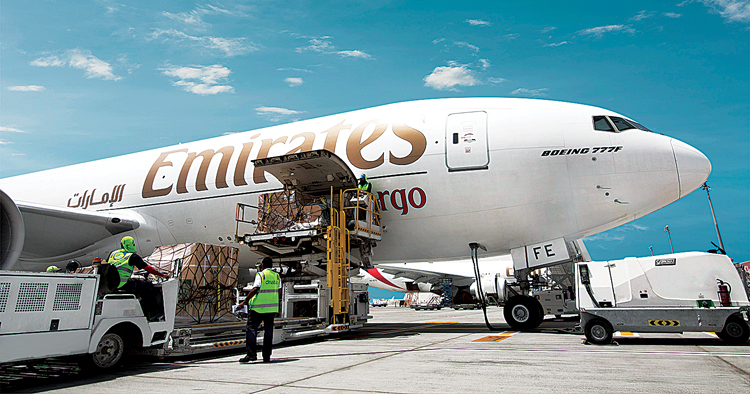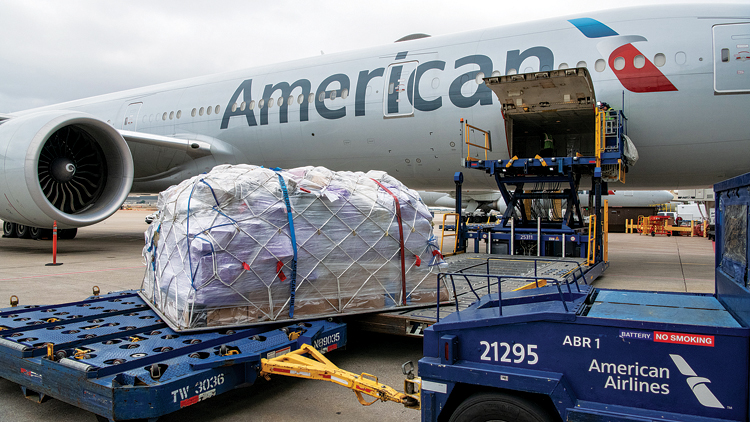INDIAN ARMED FORCES CHIEFS ON OUR RELENTLESS AND FOCUSED PUBLISHING EFFORTS

SP Guide Publications puts forth a well compiled articulation of issues, pursuits and accomplishments of the Indian Army, over the years

"Over the past 60 years, the growth of SP Guide Publications has mirrored the rising stature of Indian Navy. Its well-researched and informative magazines on Defence and Aerospace sector have served to shape an educated opinion of our military personnel, policy makers and the public alike. I wish SP's Publication team continued success, fair winds and following seas in all future endeavour!"

Since, its inception in 1964, SP Guide Publications has consistently demonstrated commitment to high-quality journalism in the aerospace and defence sectors, earning a well-deserved reputation as Asia's largest media house in this domain. I wish SP Guide Publications continued success in its pursuit of excellence.
Stellar Year for Air Cargo in 2021
The data released by IATA for global air freight markets showed that full-year demand for air cargo increased by 6.9 per cent in 2021

When the pandemic brought the aviation industry to a halt, cargo aviation came to the forefront to handle the situation of constant transporting of medical aids and stranded passengers across countries. Many commercial airlines also transitioned their carriers to be used for cargo purposes. Though the demand for cargo had its moments of fluctuations through the time, International Air Transport Association (IATA) noted that 2021 turned out to be an outstanding year for Air Cargo with a strong performance in December that witnessed the year-on-year going up 18.7 per cent. The data released by IATA for global air freight markets showed that full-year demand for air cargo increased by 6.9 per cent in 2021, compared to 2019 (pre-covid levels) and 18.7 per cent compared to 2020 following a strong performance in December 2021. “This was the second biggest improvement in year-on-year demand since IATA started to monitor cargo performance in 1990 (behind 2010’s 20.6 per cent gain), outpacing the 9.8 per cent rise in global goods trade by 8.9 percentage points,” the association noted. According to IATA’s Air Cargo Market Analysis, throughout the year, air cargo has been driven by a balance between robust demand for goods – including PPE at the end of the year – and supply chain issues partly linked to a lack of capacity.
Global demand in 2021, measured in cargo tonne-kilometers (CTKs), was up 6.9 per cent compared to 2019 (7.4 per cent for international operations) while the capacity was noted to be 10.9 per cent below 2019 (-12.8 per cent for international operations) as the capacity remained constrained with bottlenecks at key hubs. December witnessed improvements as global demand went 8.9 per cent above 2019 levels (9.4 per cent for international operations), a significant improvement from the 3.9 per cent increase in November and the best performance since April 2021 (11.4 per cent).

The IATA also highlighted the following economic conditions that continue to support air cargo growth:
- Global goods trade rose 7.7 per cent in November 2021, compared to pre-crisis levels. Global industrial production was up 4.0 per cent over the same period.
- The inventory-to-sales ratio remains low. This is positive for air cargo as manufacturers turn to air cargo to rapidly meet demand.
- The cost-competitiveness of air cargo relative to that of seacontainer shipping remains favorable.
- The surge in COVID-19 cases in many advanced economies created strong demand for PPE shipments, which are usually carried by air.
- Labour shortages, partly due to employees being in quarantine, insufficient storage space at some airports and processing backlogs continue to put pressure on supply chains.
- The December global Supplier Delivery Time Purchasing Managers Index (PMI) was at 38. While values below 50 are normally favorable for air cargo, in current conditions it points to delivery times lengthening because of supply bottlenecks.
IATA’s Director General, Willie Walsh pointed out how air cargo provided a vital source of revenue for many airlines as passenger demand remained in the doldrums due to COVID-19 travel restrictions. He is also optimistic about overall, economic conditions pointing towards a strong 2022.
Strong demand allowed world goods trade to increase by around 9.8 per cent year-on-year in 2021. Air cargo growth was twice as strong than the rebound in trade, exceeding this by 8.9 per cent percentage points (ppts), a typical pattern during economic upturns. During such periods, businesses are often faced with surging demand, and turn to air freight to meet it rapidly, leading to an inventory restocking cycle, the analysis noted.
This was the second biggest improvement in year-on-year demand since IATA started to monitor cargo performance in 1990
“Some relief on supply chain constraints occurred naturally in December as volumes decreased after peak shipping activity ended in advance of the Christmas holiday. This freed capacity to accommodate front-loading of some Lunar New Year shipments to avoid potential disruptions to flight schedules during the Winter Olympic games. And overall December cargo performance was assisted by additional belly-hold capacity as airlines accommodated an expected year-end boost to travel. As shortages of labour and storage capacity remain, governments must keep a sharp focus on supply chain constraints to protect the economic recovery,” Walsh added.
2021 Regional Performance
Regionally also, air cargo saw strong variations in 2021 compared to 2019, IATA noted.
North American carriers emerged as the strongest performers, reporting an annual increase in international demand of 20.2 per cent. Middle Eastern, African, Asia-Pacific and European carriers also saw rise international demand in 2021 compared to 2019, the associated reported.

Asia-Pacific airlines saw a rise of 3.6 per cent in international demand in 2021 compared to 2019 and a fall in international capacity of 17.1 per cent. In December, airlines in the region posted an 8.8 per cent increase in international demand compared to 2019.
North American carriers reported a 20.2 per cent increase in international demand in 2021 compared to 2019 and a growth in international capacity of 0.2 per cent. In December, the carriers in the region posted an increase of 20.5 per cent in international demand. The region was the only one to record a growth in capacity in 2021 compared to 2019 with international capacity growing 6.2 per cent compared to December 2019.
REGIONAL PERFORMANCE
| Air Cargo Year to Date Developments (January-December 2021) | CTK | ACTK | CLF (%-PT)² | CLF (Level)³ |
|---|---|---|---|---|
| Total Market | 6.9% | -10.9% | 9.3% | 56.1% |
| Africa | 10.2% | -16.1% | 11.4% | 47.6% |
| Asia-Pacific | 0.2% | -18.0% | 11.7% | 64.0% |
| Europe | 3.7% | -16.5% | 12.5% | 64.4% |
| Latin America | -15.4% | -32.6% | 9.0% | 44.1% |
| Middle East | 10.5% | -10.1% | 10.7% | 57.4% |
| North America | 19.8% | 4.0% | 6.0% | 45.5% |
Source: IATA
While European carriers reported a 3.6 per cent increase in international demand in 2021 compared to 2019 and a fall in capacity of 17.4 per cent. In December airlines posted an increase in international demand of six per cent compared to 2019. IATA also pointed out that the European carriers have been significantly affected by supply chain and airport congestion and localised capacity constraints.
Middle Eastern carriers posted an increase in international demand of 10.6 per cent in 2021 compared to 2019 and a fall in international capacity of 10.1 per cent. In December airlines in the region recorded a 5.7 per cent increase in international demand compared to December 2019. International capacity decreased by 9.2 per cent in December compared to the same month in 2019.
African airlines also saw international demand grow 11.3 per cent in 2021 compared to 2019 but there was a fall in international capacity of 14.6 per cent. Growth in the region was dynamic for most of the year, driven by the strength of the Africa-Asia route. In December, international demand grew by 7.6 per centwith international capacity falling 19.4 per cent as compared to the same month in 2019.
Latin American carriers on the other hand, reported a decline in international demand of 15.2 per cent in 2021 compared to 2019 and a fall in capacity of 30.2 per cent. Even then, there was a significant improvement in December.
All in all, even amid fluctuations, air freight activity has been among the most stable one in the aviation industry through this highly volatile and uncertain time.





